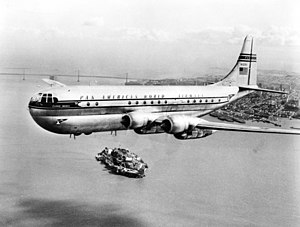| Boeing 377 Stratocruiser | |
|---|---|
 A Pan Am Stratocruiser over San Francisco Bay | |
| General information | |
| Type | Airliner |
| National origin | United States |
| Manufacturer | Boeing Commercial Airplanes |
| Primary user | Pan American World Airways |
| Number built | 56[1][2] |
| History | |
| Introduction date | April 1, 1949, with Pan American World Airways |
| First flight | July 8, 1947 |
| Retired | 1963 |
| Developed from | Boeing C-97 Stratofreighter |
| Variants | Aero Spacelines Pregnant Guppy Aero Spacelines Super Guppy Aero Spacelines Mini Guppy |
The Boeing 377 Stratocruiser was a large long-range airliner developed from the C-97 Stratofreighter military transport, itself a derivative of the B-29 Superfortress. The Stratocruiser's first flight was on July 8, 1947.[3] Its design was advanced for its day; its relatively innovative features (though neither completely new) included two passenger decks and a pressurized cabin. It could carry up to 100 passengers on the main deck plus 14 in the lower deck lounge; typical seating was for 63 or 84 passengers or 28 berthed and five seated passengers.
The Stratocruiser was larger than the Douglas DC-6 and Lockheed Constellation and cost more to buy and operate. Its reliability was poor, chiefly due to problems with the four 28-cylinder Pratt & Whitney R-4360 Wasp Major radial engines and structural and control problems with their propellers. Only 55 Model 377s were built for airlines, along with the single prototype. A 377 was also converted into the Aero Spacelines Pregnant Guppy by John M. Conroy for NASA’s Gemini space program.
- ^ "Boeing: Historical Snapshot: Model 377 Stratocruiser Commercial Transport". www.boeing.com.
- ^ "Boeing 377 Stratocruiser". www.aviation-history.com.
- ^ "Boeing History: Stratocruiser Commercial Transport". Boeing.com. July 8, 1947. Archived from the original on June 6, 2012. Retrieved June 18, 2012.